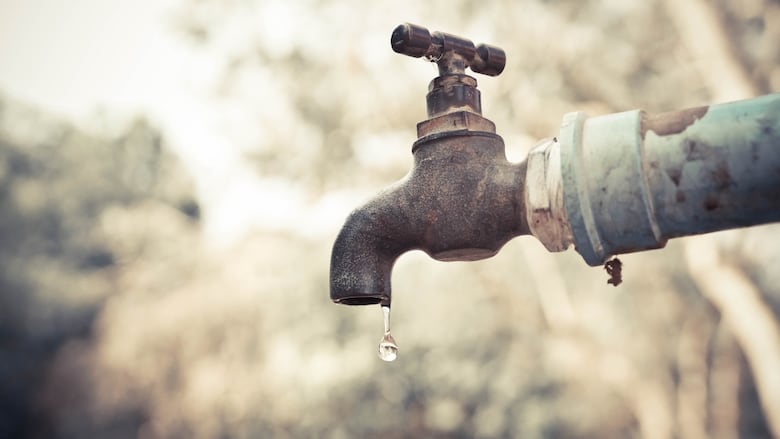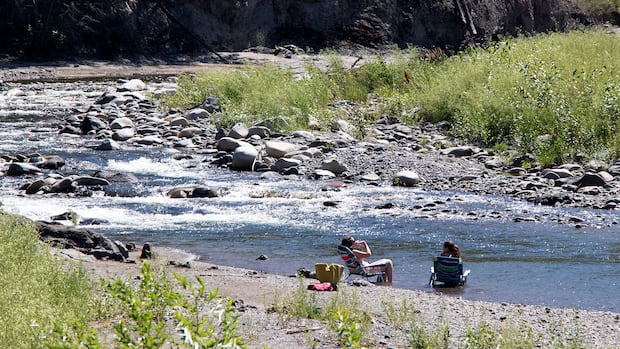Restrictions in effect in Dawson Creek, B.C., as persistent drought dries up water supply
City says urgency to secure new water supply now critical

As drought persists in some parts of northeastern B.C., Dawson Creek says it is imposing restrictions to conserve drinking water starting Friday, with officials warning the city may soon have to rely solely on its reservoirs if dry conditions persist.
The restrictions come as the region enters its fourth straight year of hot, dry weather, a pattern city officials trace back to the 2021 heat dome. Since then, low snowpacks and scarce rainfall have severely strained the city's only water source, the Kiskatinaw River.
Officials say the current situation is likely to get worse before it gets better, and the urgency to secure a new water supply is now critical.
"It's extremely concerning. Water levels are the lowest I think that we have recorded in history," said Mayor Darcy Dober. "Without a lot of moisture and water in the forecast, it's inevitable that we're not going to be able to pump out of the Kiskatinaw, and we're going to have to use our reservoirs."
Watershed at 'tipping point'
Dawson Creek draws its drinking water from the Kiskatinaw River, which is fed by Bearhole Lake, a protected area in the eastern foothills of the Rockies. Unlike glacial-fed waters, both depend entirely on seasonal rain and snow.
In Bearhole Lake, water levels have dropped more than 20 centimetres below a weir built in 2009 to capture water and replenish river flows in dry years. The Kiskatinaw itself is at historic lows not seen since 1992, according to the city.
"What we're seeing now in the Kiskatinaw is a trajectory that is a bit unsettling. It is low flows, much like last year, but we're seeing it drop quicker and sooner," said Kevin Henderson, the city's chief administrative officer, who has dealt with water infrastructure issues throughout much of his 30-year career working for the city.
Henderson says river levels may soon fall below the city's daily water demand, forcing Dawson Creek to begin drawing from its storage reservoirs just to meet basic needs.
"We are getting to a point here in the coming days where the flows in the river will be potentially lower than what our daily demand is in the community," Henderson said. "That means we're going to start to be in a bit of a negative position where we're going to have to rely on our storage reservoirs to augment what we are unable to pump out of the river."
"And if we get a cold, early shot of winter, that river could freeze and limit our ability to withdraw water," he added. "We would be reliant on our storage reservoirs all winter long."
Winter scare reignited 2013 pipeline plans
In January 2024, the Kiskatinaw froze solid, forcing the city to rely entirely on stored water for six weeks and implement restrictions. That revived discussions on building a new pipeline, first proposed in 2013, to tap into a new water source from either the Peace or Murray rivers.
"Since then, so about 18 months, it's been our number one priority," said Dober. "We realized, at that point, that all the work that [previous] councils have done were great to get us where we were, but we were still at the point where we didn't have a reliable water source and we need that — not only for Dawson Creek, but for the [neighbouring] Village of Pouce Coupe and the Peace River Regional District.
"Our water source is a reliable source for a lot of people, not just in the city."
Such a project won't be easy. A pipeline from the Peace River would span some 55 kilometres, and early estimates suggest the price tag could exceed $100 million.
City officials say that's not something the local tax base can carry or do alone. They've also asked the province for an exemption from a lengthy environmental assessment process, which could take two to five years to complete.
"We don't have two to five years," Dober said. "We need to get this moving quick. Once we can get a permit and that approval, then we've got to figure out how we're getting it done."
Restrictions begin Friday
Stage 2 water restrictions go into effect July 25, limiting residential lawn watering and industrial water use, including bulk withdrawals for hydraulic fracturing.
"Right now, we're not seeing a lot of industrial demand," Henderson said. "What it will do is just ensure that we don't have any of that demand come online in the coming days or weeks that would put further stress on the system."
While Dawson Creek has about 200 days worth of water stored in city reservoirs, officials are cautious about drawing it down too quickly. If dry weather continues, more restrictions could follow, including shutdowns of car washes and recreational facilities like water parks.
"It all depends on the weather," Henderson said. "If we have a wet fall, that certainly can help us ... If we have a very hot August and it stretches through September with no moisture, then things are likely going to get a little bit more complicated, and we're going to have to make some further decisions on conservation measures."
